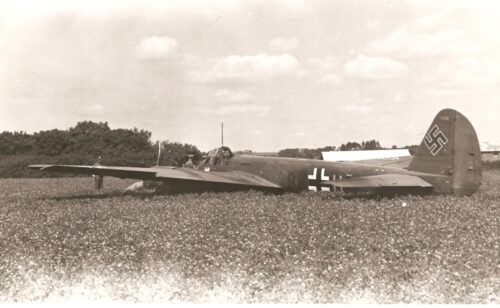After the occupation of northern France 3/KG 51 ‘Edelweiss’ [3rd Squadron of Bomber Wing 51] moved its base from Paris-Orly to Melun-Villaroche aerodrome, southeast of Paris.
On Saturday 27 July 1940 at about 22:30 hours a Junkers Ju 88 bomber took off on a mission to bomb the railway town of Crewe in Cheshire. During the long flight the land below them was blacked out so that the crew were not aware of their true position until they encountered a city with no blackout and realised it was Dublin, in neutral Eire.
They then flew east and south and eventually overflew London. The fact that they were not attacked over this large city led them to believe that they were over Paris. Hoping to locate their home airfield, and failing, they turned north again and overflew London for a second time. Retracing their course and with dawn breaking they came to the English Channel and with the sun to their left they realised their true position. With fuel very low, not even allowing an attempt to cross the Channel, a landing had to be made immediately. The 4 bombs were jettisoned and the pilot flew the aeroplane over Bexhill aiming for the open country to the north of the town.
The Junkers executed a wheels-up landing coming under fire from the soldiers of a nearby searchlight battery. The bomber came to rest by the Mile Lane leading to Buckholt Farm from Watermill Lane.
The above are images of the Junkers after its crash landing, lying in a field near Buckholt Farm.
The crew comprised:
- Pilot: Oberfeldwebel Josef Bier
- Navigator: Leutnant Willi Ruckdreschel
- Radio operator: Unteroffizier Heinz Ohls
- Gunner: Unteroffizier Martin Multhammer
-

Navigator: Leutnant Willi Ruckdreschel
-

Pilot: Oberfeldwebel Josef Bier
They were taken prisoner by the soldiers of the searchlight battery. The pilot Josef Bier (see photo on left) spent most of his captivity in a prisoner of war camp in Calgary, Canada, returning to Germany in 1947. His operational flights totalled 19 missions over France and 6 to the UK. Targets in England were Bristol, Portland, Gloucester, Liverpool, Southampton and, finally, the abortive flight to Crewe.
The Ju 88, serial number 7036 was dismantled and subject to study by Royal Air Force intelligence.
It was transported to the Royal Aircraft Establishment at Farnborough. Here it was decided that the airframe could be repaired and made airworthy. It was repainted in the standard RAF camouflage scheme for experimental types of brown and green upper surfaces with yellow under surfaces; given RAF roundels and taken on charge with the serial number AX919.
The aircraft proved to be difficult to keep serviceable and only made 4 flights, a total of 2 hours 10 minutes. In June 1942 it was taken by road to 1426 [Enemy Aircraft] Flight [known as the Rafwaffe] at Duxford. A unit which evaluated and demonstrated captured enemy aircraft. Here its fate was to be cannibalised to provide components and spares for the other Ju 88 used by the unit.
The Junkers 88 being removed from Buckholt and transported to the Royal Aircraft Establishment at Farnborough






